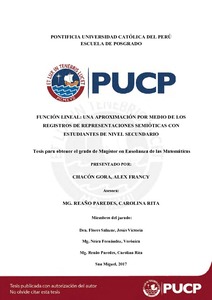| dc.contributor.advisor | Reaño Paredes, Carolina Rita | |
| dc.contributor.author | Chacón Gora, Alex Francy | es_ES |
| dc.date.accessioned | 2017-11-27T15:51:35Z | es_ES |
| dc.date.available | 2017-11-27T15:51:35Z | es_ES |
| dc.date.created | 2017 | es_ES |
| dc.date.issued | 2017-11-27 | es_ES |
| dc.identifier.uri | http://hdl.handle.net/20.500.12404/9756 | |
| dc.description.abstract | La presente investigación tiene como objetivo analizar si una secuencia de actividades
favorece la aproximación al concepto de función lineal diseñada con base en la Teoría de
Registros de Representación Semiótica, en estudiantes de secundaria de una Institución
Educativa pública en Lima (Perú).
Para este trabajo, hemos revisado antecedentes de investigación, los cuales tienen como
objeto matemático a la función lineal. Estos nos han servido para diseñar nuestras actividades
a partir de las dificultades que presentan los estudiantes cuando se enfrentan al estudio de la
función lineal. Como marco teórico, hemos tomado aspectos de la Teoría de Registros de
Representación Semiótica (TRRS), los cuales brindan elementos necesarios para comprender
cómo se aproximan a la noción de función lineal, la metodología empleada para alcanzar el
objetivo general de nuestra investigación, por ser cualitativa experimental, son aspectos de la
Ingeniería Didáctica. Para realizar el análisis, hemos seleccionado, de forma aleatoria, a dos
estudiantes que participaron en las tres actividades.
Respecto a la experimentación y análisis de los resultados, elaboramos y aplicamos una
secuencia de tres actividades: la primera y segunda actividad constan de tres preguntas; la
tercera, de seis. Estas fueron elaboradas con la intención de que los estudiantes transiten por
los diversos registros de representación semiótica y se aproximen a la noción de función
lineal. Los resultados conseguidos nos muestran que María logró transitar por los siguientes
registros de representación semiótica: lengua natural, numérico, algebraico y gráfico, con lo
cual creemos que ella se aproximó a la noción de función lineal; en cambio, Juan tuvo
dificultades en comprender el propósito de algunas preguntas, en realizar la conversión del
registro de lengua natural al registro algebraico y en explicar y justificar sus respuestas en
lenguaje natural.
Finalmente, creemos que la primera pregunta de la segunda y tercera actividad jugaron un
papel importante para el logro de nuestros objetivos y nos permitió, en primer lugar,
identificar los tratamientos y conversiones que realizan los estudiantes y, en segundo lugar,
pudimos distinguir cómo va surgiendo la noción de función lineal en ellos: el marco teórico
de la TRRS nos permitió explicar cómo se lleva este proceso. | es_ES |
| dc.description.abstract | The present research aims to analyze if a sequence of activities favors the approximation to
the concept of linear function designed based on the Theory of Semiotic Representation
Records in high school students of a Public Educational Institution in Lima Peru.
For this work, we have reviewed a research background which has as a mathematical object
the linear function, which has served us to design our activities based on the difficulties that
students face when confronted in the study of linear function. For this work we have taken as
theoretical framework aspects of the Theory of Registers of Semiotic Representation (TRRS)
which provides us with the necessary elements to understand how the approach to linear
function is approached, the methodology used to achieve the general objective of our
Research, being experimental qualitative, are aspects of Didactic Engineering. To perform the
analysis we selected two students randomly, who participated in the three activities.
Regarding the experimentation and analysis of the results, we elaborate and apply a sequence
of three activities: the first and second activity consist of three questions, the third activity
consists of six questions. These were elaborated with the intention that the students transit
through the diverse registers of semiotic representation and approach the notion of linear
function. The results obtained show that Maria managed to transit through the following
registers of semiotic representation: natural, numerical, algebraic and graphical language, with
which we believe that Mary approached the notion of linear function, but Juan had difficulties
in understanding the purpose Of some questions, in the conversion of the natural language
register to the algebraic register and in explaining and justifying their responses in natural
language.
Finally, we believe that the first question, of the second and third activity, played an important
role in the achievement of our objectives, and allowed us to first identify the treatments and
conversions that the students perform, and secondly we were able to distinguish how the
Notion of linear function in them, and the theoretical framework of the TRRS, allowed us to
explain how this process is carried out. | es_ES |
| dc.language.iso | spa | es_ES |
| dc.publisher | Pontificia Universidad Católica del Perú | es_ES |
| dc.rights | info:eu-repo/semantics/openAccess | es_ES |
| dc.rights.uri | http://creativecommons.org/licenses/by-nc-nd/2.5/pe/ | * |
| dc.subject | Funciones (Matemáticas) | es_ES |
| dc.subject | Matemáticas--Estudio y enseñanza (Secundaria) | es_ES |
| dc.subject | Educación secundaria--Investigaciones | es_ES |
| dc.title | Función lineal: una aproximación por medio de los registros de representaciones semióticas con estudiantes de nivel secundario | es_ES |
| dc.type | info:eu-repo/semantics/masterThesis | es_ES |
| thesis.degree.name | Maestro en la enseñanza de las Matemáticas | es_ES |
| thesis.degree.level | Maestría | es_ES |
| thesis.degree.grantor | Pontificia Universidad Católica del Perú. Escuela de Posgrado | es_ES |
| thesis.degree.discipline | Enseñanza de las Matemáticas | es_ES |
| renati.discipline | 199117 | es_ES |
| renati.level | https://purl.org/pe-repo/renati/level#maestro | es_ES |
| renati.type | http://purl.org/pe-repo/renati/type#tesis | es_ES |
| dc.publisher.country | PE | es_ES |
| dc.subject.ocde | https://purl.org/pe-repo/ocde/ford#5.03.01 | es_ES |






